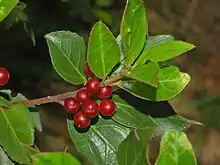Rhamnus alaternus
Rhamnus alaternus is a species of flowering plant in the buckthorn family known by the common name of Italian buckthorn or Mediterranean buckthorn.In Australia, where it was introduced as a garden shrub, it has become a serious invasive woody weed in many areas, especially coastal parts of SE Australia. Here it displaces native shrubs of similar size eg Sea Box Alyxia buxifolia(an endemic plant which had an important medicinal role for aboriginal people) and prevents subshrubs and herbaceous ground cover native plants from surviving due the heavy shade (it can form dense thickets with very low biodiversity) and competition for moisture and nutrients .
| Mediterranean buckthorn | |
|---|---|
 | |
| Leaves and berries | |
.jpg.webp) | |
| Scientific classification | |
| Kingdom: | Plantae |
| Clade: | Tracheophytes |
| Clade: | Angiosperms |
| Clade: | Eudicots |
| Clade: | Rosids |
| Order: | Rosales |
| Family: | Rhamnaceae |
| Genus: | Rhamnus |
| Species: | R. alaternus |
| Binomial name | |
| Rhamnus alaternus | |
| Synonyms | |
Etymology
The genus name derives from the Ancient Greek "rabdos", or “stick” with reference to the presence in many species of woody spine on the end of each twig. The specific Latin name alaternus, assonant with "alternus" or “alternate”, refers to the alternate leaves.
Description
Rhamnus alaternus is an evergreen shrub 1–5 metres (3 ft 3 in–16 ft 5 in) high.[1] The stems have reddish bark and pubescent young branches, rounded and compact foliage with alternating leaves, 2–6 centimetres (0.79–2.36 in) long,[1] sometimes nearly opposite, oval or lanceolate, leathery, shiny green, yellowish-green underneath.
The small fragrant flowers are gathered in a short axillary yellow-green raceme. The flowering period extends from February to April. Fruits are obovoidal red-brownish drupes of about 3–4 millimetres (0.12–0.16 in),[1] containing from 2 to 4 seeds. The drupes darken to black when ripe. Fruits have medicinal properties and can be used with caution as a laxative.
Distribution and habitat
This species is widespread in thermophilic evergreen bush and scrubland of the Mediterranean climate regions, from sea level up to 700 m above sea level.[1]
Cultivation
This species is cultivated as an ornamental garden shrub, valued for its glossy evergreen leaves and red berries. The variegated cultivar 'Argenteovariegata'[2] has gained the Royal Horticultural Society's Award of Garden Merit.[3][4]
Subspecies
Gallery

Habit 
Habit 
Male flowers 
Foliage and fruit
References
- Pignatti S. - Flora d'Italia – Edagricole – 1982. Vol. II, pag. 78
- "RHS Plant Selector - Rhamnus alaternus 'Argenteovariegata'". Retrieved 30 May 2013.
- "AGM Plants - Ornamental" (PDF). Royal Horticultural Society. July 2017. p. 84. Retrieved 23 September 2018.
- "AGM Plants - Ornamental" (PDF). Royal Horticultural Society. July 2017. p. 84. Retrieved 23 September 2018.
- Pignatti S. - Flora d'Italia - Edagricole – 1982 Vol. II, pg. 78
- Plants.USDA
- Biolib
External links
| Wikimedia Commons has media related to Rhamnus alaternus. |